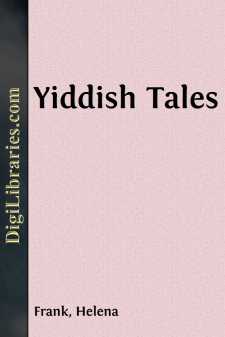Categories
- Antiques & Collectibles 13
- Architecture 36
- Art 48
- Bibles 22
- Biography & Autobiography 813
- Body, Mind & Spirit 142
- Business & Economics 28
- Children's Books 17
- Children's Fiction 14
- Computers 4
- Cooking 94
- Crafts & Hobbies 4
- Drama 346
- Education 46
- Family & Relationships 57
- Fiction 11829
- Games 19
- Gardening 17
- Health & Fitness 34
- History 1377
- House & Home 1
- Humor 147
- Juvenile Fiction 1873
- Juvenile Nonfiction 202
- Language Arts & Disciplines 88
- Law 16
- Literary Collections 686
- Literary Criticism 179
- Mathematics 13
- Medical 41
- Music 40
- Nature 179
- Non-Classifiable 1768
- Performing Arts 7
- Periodicals 1453
- Philosophy 64
- Photography 2
- Poetry 896
- Political Science 203
- Psychology 42
- Reference 154
- Religion 513
- Science 126
- Self-Help 84
- Social Science 81
- Sports & Recreation 34
- Study Aids 3
- Technology & Engineering 59
- Transportation 23
- Travel 463
- True Crime 29
Yiddish Tales
by: Helena Frank
Description:
Excerpt
PREFACE
This little volume is intended to be both companion and complement to "Stories and Pictures," by I. L. Perez, published by the Jewish Publication Society of America, in 1906.
Its object was twofold: to introduce the non-Yiddish reading public to some of the many other Yiddish writers active in Russian Jewry, and—to leave it with a more cheerful impression of Yiddish literature than it receives from Perez alone. Yes, and we have collected, largely from magazines and papers and unbound booklets, forty-eight tales by twenty different authors. This, thanks to such kind helpers as Mr. F. Hieger, of London, without whose aid we should never have been able to collect the originals of these stories, Mr. Morris Meyer, of London, who most kindly gave me the magazines, etc., in which some of them were contained, and Mr. Israel J. Zevin, of New York, that able editor and delightful feuilletonist, to whose critical knowledge of Yiddish letters we owe so much.
Some of these writers, Perez, for example, and Sholom-Alechem, are familiar by name to many of us already, while the reputation of others rests, in circles enthusiastic but tragically small, on what they have written in Hebrew. Such are Berdyczewski, Jehalel, Frischmann, Berschadski, and the silver-penned Judah Steinberg. On these last two be peace in the Olom ho-Emess. The Olom ha-Sheker had nothing for them but struggle and suffering and an early grave.
Berschadski's "Forlorn and Forsaken," Frischmann's "Three Who Ate," and Steinberg's "A Livelihood" and "At the Matzes," though here translated from the Yiddish versions, were probably written in Hebrew originally. In the case of the former two, it would seem that the Yiddish version was made by the authors themselves, and the same may be true of Steinberg's tales, too.
The tales given here are by no means all equal in literary merit, but they have each its special note, its special echo from that strangely fascinating world so often quoted, so little understood (we say it against ourselves), the Russian Ghetto—a world in the passing, but whose more precious elements, shining, for all who care to see them, through every page of these unpretending tales, and mixed with less and less of what has made their misfortune, will surely live on, free, on the one hand, to blend with all and everything akin to them, and free, on the other, to develop along their own lines—and this year here, next year in Jerusalem.
The American sketches by Zevin and S. Libin differ from the others only in their scene of action. Lerner's were drawn from the life in a little town in Bessarabia, the others are mostly Polish. And the folk tale, which is taken from Joshua Meisach's collection, published in Wilna in 1905, with the title Ma'asiyos vun der Baben, oder Nissim ve-Niflo'os, might have sprung from almost any Ghetto of the Old World.
We sincerely regret that nothing from the pen of the beloved "Grandfather" of Yiddish story-tellers in print, Abramowitsch (Mendele Mocher Seforim), was found quite suitable for insertion here, his writings being chiefly much longer than the type selected for this book. Neither have we come across anything appropriate to our purpose by another old favorite, J. Dienesohn. We were, however, able to insert three tales by the veteran author Mordecai Spektor, whose simple style and familiar figures go straight to the people's heart.
With regard to the second half of our object, greater cheerfulness, this collection is an utter failure. It has variety, on account of the many different authors, and the originals have wit and humor in plenty, for wit and humor and an almost passionate playfulness are in the very soul of the language, but it is not cheerful, and we wonder now how we ever thought it could be so, if the collective picture given of Jewish life were, despite its fictitious material, to be anything like a true one. The drollest of the tales, "Gymnasiye" (we refer to the originals), is perhaps the saddest, anyhow in point of actuality, seeing that the Russian Government is planning to make education impossible of attainment by more and more of the Jewish youth—children given into its keeping as surely as any others, and for the crushing of whose lives it will have to answer....




